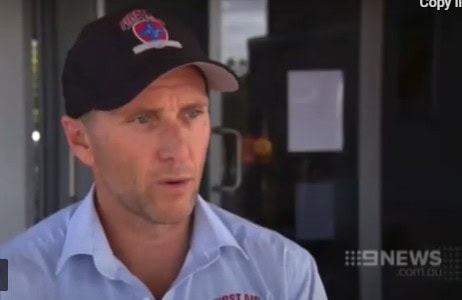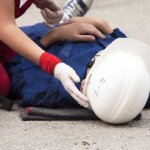Defibrillator used in First Aid course

Defibrillator used in First Aid course: A True Test of CPR and Defibrillator Skills
On Thursday, October 29, 2015, a life was saved in a First Aid course on the Gold Coast. A routine First Aid and CPR training session at First Aid Accident and Emergency’s (FAAE) Varsity Lakes headquarters turned into an extraordinary real-life demonstration of the life-saving power of CPR and defibrillation. The day was supposed to be like any other training session, where participants would learn how to handle medical emergencies in the safest and most effective way possible. However, the situation took an unexpected turn when one of the trainees, Peter Cary, collapsed and went into cardiac arrest, prompting the trainees and instructors to use their newly acquired skills in a real emergency.
Watch the story here:
The Unpredictable Nature of Cardiac Arrest can happen anywhere at any time:
Peter Cary, a 46-year-old sailing club volunteer, was one of 20 participants in the First Aid and CPR course that day. Little did he know that during this training, he would become part of an unforgettable real-life situation that would test not only his life but also the skills of everyone around him. As the class was in the middle of a role-playing exercise, where participants were practicing CPR techniques on each other, Mr. Cary began to exhibit symptoms that suggested he might be experiencing a heart attack.
At first, the situation seemed like just another role-play. The first aid instructor, Wendy Sullivan, assumed that Peter was simply acting out a scenario as part of the training. However, as the symptoms became more pronounced, and it became clear that Peter’s condition was deteriorating rapidly, Wendy quickly realized that this was not a practice session—it was a real medical emergency.
Immediate Action by First Aid Trainer Wendy Sullivan
As a qualified First Aid trainer, Wendy Sullivan was well-equipped to handle the situation. She sprang into action, assessing Peter’s condition in a calm and composed manner. Wendy checked Peter’s breathing and responsiveness and quickly determined that he was unresponsive and had stopped breathing, a classic sign of cardiac arrest. Without hesitation, Wendy immediately began performing CPR (cardiopulmonary resuscitation) to keep Peter’s blood circulating until more advanced medical help could arrive.
Wendy remained focused on her role, calmly instructing the students to contact the administration team and call emergency services at 000, the Australian emergency number. While Wendy continued administering CPR, another student was tasked with retrieving the defibrillator from the training facility. A defibrillator is a life-saving device that can deliver an electrical shock to the heart in the event of cardiac arrest, potentially restoring a normal heart rhythm.
The Use of the Defibrillator
The defibrillator, a HeartSine 360p model, was retrieved and brought to the scene. Though the students were not fully trained in its use, they had received some prior instruction on how to operate the device. The team of students, under Wendy’s guidance, worked together to administer the defibrillator while continuing with CPR. It was a high-pressure, real-life situation that tested both their technical skills and ability to stay calm under pressure.
For a total of 8 minutes and 24 seconds, Wendy and her team worked tirelessly, administering CPR and using the defibrillator to attempt to revive Peter. As time passed, it became evident that the efforts of the team were paying off. Peter’s pulse was restored just before the ambulance arrived, and he was rushed to Allamanda Hospital on the Gold Coast.
Think about installing a workplace Defibrillator Bundle today, FAAE has an extensive range of workplace Defibrillators and first aid kits.

Patient makes a Full recovery:
Thanks to the quick thinking and coordinated actions of the training group, Peter Cary made a full recovery. His survival is a testament to the effectiveness of CPR and defibrillator use in cardiac emergencies. Peter was fortunate that the First Aid course he was attending prepared the participants with the necessary skills to act decisively in such a situation. His story serves as a powerful reminder of the importance of first aid training and being prepared to handle medical emergencies, no matter how unexpected they may be.
Following the incident, Scott Whimpey, the director of First Aid Accident and Emergency, praised the actions of the team, as well as the students, who demonstrated their ability to handle a real emergency situation. Scott emphasized the importance of up-to-date First Aid and CPR training, noting that the successful resuscitation of Peter Cary was a clear demonstration that the knowledge and equipment provided in the training could indeed save lives.
“Our students have had a real-life emergency. We’ve now proven that our defibrillators and training save lives,” Scott Whimpey stated.
The Importance of First Aid and CPR Training
While the incident was undoubtedly a traumatic experience for everyone involved, it was also a profound learning opportunity for the students, instructors, and staff at FAAE. The situation reinforced the critical importance of having up-to-date First Aid and CPR training. Medical emergencies can happen at any time, and the ability to respond quickly and effectively can make the difference between life and death.
In Australia, approximately one person suffers a heart attack every 12 minutes. Shockingly, an estimated 24 people each day do not survive. These statistics highlight just how crucial it is to have access to life-saving equipment, such as defibrillators, and the training needed to use them properly. Whether at home, at work, or during public events, knowing how to perform CPR and operate a defibrillator can be the difference between a tragic outcome and a successful recovery.
A life saved in a First Aid course on the Gold Coast and how training can make a difference:
The experience with Peter Cary is a prime example of why First Aid courses are so valuable. First Aid training courses, such as those offered by First Aid Accident and Emergency, equip participants with the skills and confidence to handle a variety of medical situations. These courses are recommended by the Australia Resuscitation Council and cover everything from basic First Aid and CPR techniques to more advanced resuscitation methods. Each course is designed to prepare participants for real-life situations where they may need to act quickly and decisively.
The FAAE offers a range of First Aid courses, including basic CPR training and advanced resuscitation courses. Instructors like Wendy Sullivan ensure that students are fully equipped to respond effectively in emergencies. Participants are taught to recognize the symptoms of heart attacks, strokes, and other medical emergencies, as well as how to perform life-saving techniques like CPR and defibrillation. By incorporating real-life scenarios into the training, FAAE ensures that students are well-prepared to handle any situation that may arise.
The Value of Defibrillators in Emergency Situations
Defibrillators are a critical component of emergency medical response, especially when it comes to cardiac arrest. These devices can deliver a controlled electrical shock to the heart to restore a normal rhythm when the heart stops beating effectively. The HeartSine 360p defibrillator used in the training course is a portable. It is user-friendly device that guides users through the process of delivering a shock if necessary.
When combined with CPR, the use of a defibrillator can significantly increase the chances of survival for someone experiencing cardiac arrest. In fact, research shows that for every minute that passes without CPR or defibrillation, the chances of survival decrease by approximately 10%. This underscores the importance of prompt action when someone is in cardiac arrest.
Saving a life must include the Skills to do CPR and use of a Defibrillator.
Peter Cary’s experience on October 29, 2015, highlights the critical importance of having life-saving skills, such as CPR and defibrillator use, and knowing how to apply them in real-world situations. The quick and decisive actions of the students and instructors at FAAE undoubtedly saved Peter’s life. This incident serves as a powerful reminder that First Aid and CPR training is not just a theoretical exercise, but a practical skill that can be the difference between life and death.
At First Aid Accident and Emergency, the mission is clear: to equip individuals with the knowledge and skills they need to respond effectively to medical emergencies. Whether you’re looking to become certified in basic First Aid, CPR, or advanced resuscitation, these courses are invaluable in preparing you to handle emergencies with confidence.
Direstor of First Aid Accident & Emergency : Scott Whimpey said: “While this was an intense time for everyone involved, having a life saved in a First Aid course on the Gold Coast was a valuable lesson for everyone involved. The fact that a heart attack can occur very fast and how vital a quick response is”. Approximately one person suffers a heart attack every 12 minutes in Australia with an estimated 24 people a day not surviving.
Mr Whimpey continued, “These statics show how important it is that people know what to do in an emergency situation”.
Make it a priority to have up-to-date First Aid training that makes a difference. Our First Aid courses cover all aspects of heart attacks, Defibrillators and CPR.
Book a course now or contact our team to book now.
 Construction Defibrillator Bundles
Construction Defibrillator Bundles